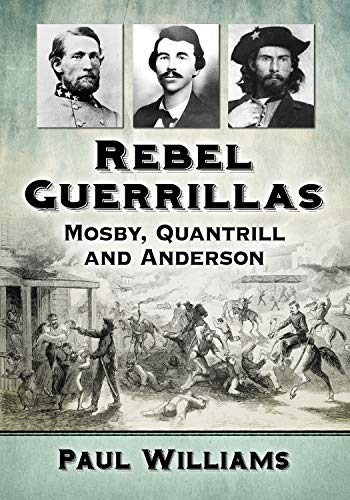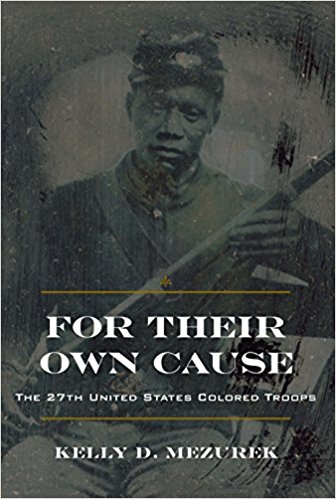Rebel Guerrillas: Mosby, Quantrill and Anderson by Paul Williams. McFarland & Company, Inc., 2018. Paper, ISBN: 978-1-4766-7573-2. $39.95.
 In a narrative history of the Civil War’s western and eastern theaters, Paul Williams studies three of the Confederate Army’s most prominent irregular warriors: John Mosby, William Quantrill, and “Bloody Bill” Anderson. Mirroring a novel with an ensemble of characters, Williams examines the three Confederates’ careers chronologically, alternating between chapters on Mosby and Quantrill and/or Anderson. The author presents a solid selection of themes and comparative analysis, but questionable additions and absences slightly weaken an otherwise stellar work.
In a narrative history of the Civil War’s western and eastern theaters, Paul Williams studies three of the Confederate Army’s most prominent irregular warriors: John Mosby, William Quantrill, and “Bloody Bill” Anderson. Mirroring a novel with an ensemble of characters, Williams examines the three Confederates’ careers chronologically, alternating between chapters on Mosby and Quantrill and/or Anderson. The author presents a solid selection of themes and comparative analysis, but questionable additions and absences slightly weaken an otherwise stellar work.
Williams splendidly documents Mosby’s fighting style and political loyalties. While the Virginian initially espoused Unionism, proclaiming a willingness to kill secessionists should a civil war break out (19-20), he followed his beloved state into the Confederacy and joined the rebel cavalry forces. Representing a headache for Union operations in northern Virginia, the “Gray Ghost” proved elusive by silently moving, wearing disguises, and scattering. As Williams notes, any unsuspecting Yankee officer, supply route, or communication line could fall victim to a sudden Mosby attack.
In March 1863, Mosby’s accumulating successes and popularity drove the Confederate government to permit him to officially serve as an independent ranger commander under the Partisan Ranger Act. His Forty-third Virginia recruited furloughed soldiers and deserters seeking a trustworthy officer, plunder, and camaraderie. Its triumphs prompted the federals to use larger numbers of troops for picket duty and counter-irregular raids. Losing to Mosby elicited Union complaints of incompetence and cowardice; rare victories led to cheers along with disappointment at not capturing the partisan chief.
After Lee’s surrender, Mosby disbanded the unit rather than surrender as well. In his last chapter, Paul Williams outlines Mosby’s postbellum defiance of the Lost Cause. He worked for Ulysses S. Grant’s re-election campaign out of a reconciliationist sentiment, emphasized slavery’s centrality to the southern republic, and defended his willingness to fight for an institution he opposed by emphasizing his patriotic duty to the South.
In his Quantrill and Anderson chapters, Williams documents the brutality of the Kansas-Missouri border war and accurately traces it to the “Bleeding Kansas” prelude to the Civil War. Known for violence, transience, and criminal behavior, William Quantrill moved to war-torn Kansas in early 1857. Due to opportunism and abolitionist atrocities, the future guerrilla shifted his allegiance from free soil to border ruffian. While serving under Sterling Price’s regulars, he joined the flood of Missouri guerrilla bands resisting jayhawker invasions. By 1862, Quantrill’s group took no quarter and attracted numerous recruits, prompting frustrated Union personnel to conduct counter-guerrilla operations (50-51, 66, 72). In August 1863, Quantrill led other rebel bushwhackers in an infamous raid on Lawrence, Kansas. Williams provides graphic accounts of the raid’s atrocities and of the U.S. reprisals, including a woman holding the charred skull of her Unionist husband and the mutilation of a lynched Quantrill straggler (112).
In a chapter on the border conflict between 1863 and 1864, Williams introduces his third main character: “Bloody Bill” Anderson. In a short biographical introduction, the author reveals that Anderson entered the war as a civilian horse thief and killer. To earn his nickname, he and his men plundered, extorted, tortured, murdered, and scalped Missouri’s Unionists. Williams includes gruesome accounts of the Anderson band massacring captured soldiers and civilians (137-141). Late in the war, Quantrill and Anderson’s reigns of terror met their demise when Union forces ambushed and killed the hated bushwhackers.
Williams makes clear that the irregular style of combat was controversial in the Confederate Army, whose commanders subscribed to nineteenth-century standards of civilized warfare. All three of the men featured in Rebel Guerrillas proudly embraced their irregular style as a legitimate form of combat and felt that their government gave them inadequate recognition. The author cites rebel leaders, including Robert E. Lee, Joseph Johnston, and Jubal Early, who denounced partisans like Mosby as mere brigands (39, 40-41, 89, 122, 150-151). Similarly, in the western border region, commanders in both armies viewed irregulars, friendly and hostile alike, as bands of murderous outlaws, not legitimate soldiers (73-74, 168).
Williams’ book has many strengths. Mosby and Quantrill/Anderson were effective choices for Williams to represent the eastern and western theaters of unconventional warfare. As Williams points out, while Mosby’s eastern campaign protected property and civilian life, the western raids of Quantrill and Anderson occupied the extreme end of the Civil War’s spectrum of brutality. Moreover, both Mosby and Quantrill shared traits: they engaged in youthful violence, drew the ire of superiors, unsuccessfully demanded promotions even though some unofficially referred to them as high-ranking officers, and constituted among the main irregular threats to the Union Army. To capture these men’s notoriety, Rebel Guerrillas makes strong use of Quantrill family correspondence; the reminiscences of Mosby, his men, and his foes; newspaper accounts; and official reports. The newspapers enrich the narrative by highlighting public sentiments on the irregular chiefs. One can compare this work with Gary W. Gallagher’s 2013 study of three other Confederate commanders—Robert E. Lee, Stephen Ramseur, and Jubal Early—examining the multifaceted nature of Confederate loyalties.
However, Rebel Guerrillas had the potential for improvement. Unlike Gallagher’s well-balanced analysis, Williams’ character development of Anderson pales in comparison to that of the other two Confederates. “Bloody Bill” first appears half-way through the book, by which point the reader has forgotten that Mosby and Quantrill are not the only subjects. Additionally, since Quantrill and Anderson each had similar reputations for carnage in Missouri and Kansas, it was perhaps unnecessary to even include Anderson. The reviewer also looked in vain for an explanation for the different natures of the western and eastern theaters. Does Williams think cultural differences and/or contrasting military situations determined the severity of irregular violence? Despite this critique, the reviewer highly recommends Rebel Guerrillas to any student or history enthusiast seeking an introduction to the Civil War’s irregular aspect.
Scott Thompson is a PhD candidate at West Virginia University. He is currently working on a dissertation on black soldier mutinies and contributed an essay to The Guerrilla Hunters (2017).
